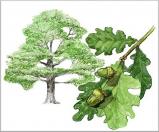English Oak - Quercus robur
A deciduous tree typical of valleys and plains; the English Oak is one of the most majestic and long living trees of the Italian flora. It can grow over 50 metres in height and live for over 500 years.
The trunk usually grows quite high before dividing into several branches. The crown is wide, and divided into regularly distributed masses.
The oblong, ovate leaves are narrow at the base, widening in the upper portion, with the margins incised into 5-7 pairs of rounded lobes.
The stalk is short and rather unnoticeable because it is usually hidden by the basal lobes. The acorns, on the contrary, have very long stalks, a peculiar characteristic and used for identification.
Of all the oaks, the English Oak is the one that has most suffered the consequences of felling and coppice management of residual woods.
Frequent felling has in fact caused the soils to loose their fertility and water retaining properties, so favouring more rustic species (it is known for certain that the European Turkey Oak and Pubescent Oak now occupy areas they once shared with the English and Durmast Oak).
Like the Durmast Oak, the English Oak supplies a very precious wood which is used for making furniture, beams and parquet flooring. Historically, wood from the English Oak has always been used in ship building.
It is a well known fact, for example, that the vast districts of woodlands dominated by English Oak, stretching from Montalbano to Mount Serratto, contributed to the wealth of the Marine Republic of Pisa: many of the felled trunks were floated down stream to the city's ship yards.
The staves for oak barrels also traditionally come from this tree. Actually the famous "Slavonian oak" used to mature the most precious wines, is really wood from the English Oak.




